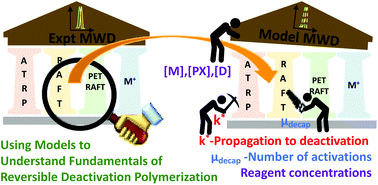A general model for the ideal chain length distributions of polymers made with reversible deactivation†
Abstract
Polymer molecular weight, or chain length distributions, are a core characteristic of a polymer system, with the distribution being intimately tied to the properties and performance of the polymer material. A model is developed for the ideal distribution of polymers made using reversible activation/deactivation of chain ends, with monomer added to the active form of the chain end. The ideal distribution focuses on living chains, with the system having minimal impact from irreversible termination or transfer. This model was applied to ATRP, RAFT, and cationic polymerizations, and was also used to describe complex systems such as blended polymers and block copolymers. The model can easily and accurately be fitted to molecular weight distributions, giving information on the ratio of propagation to deactivation, as well as the mean number of times a chain is activated/deactivated under the polymerization conditions. The mean number of activation cycles per chain is otherwise difficult to assess from conversion data or molecular weight distributions. Since this model can be applied to wide range of polymerizations, giving useful information on the underlying polymerization process, it can be used to give fundamental insights into macromolecular synthesis and reaction outcomes.

- This article is part of the themed collection: Polymer Chemistry Lectureship Winners


 Please wait while we load your content...
Please wait while we load your content...
